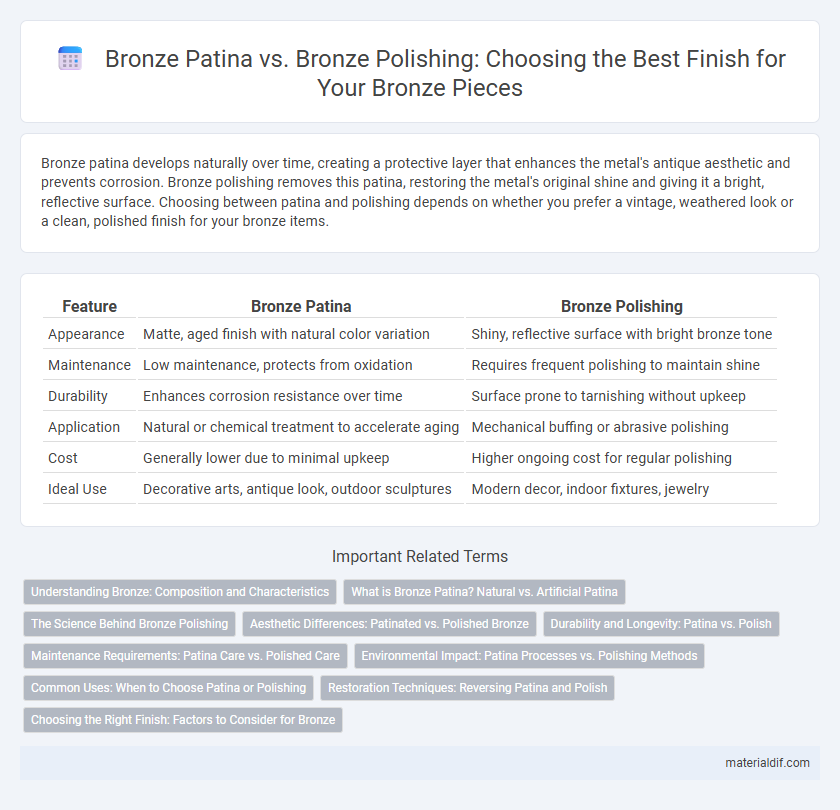Bronze patina develops naturally over time, creating a protective layer that enhances the metal's antique aesthetic and prevents corrosion. Bronze polishing removes this patina, restoring the metal's original shine and giving it a bright, reflective surface. Choosing between patina and polishing depends on whether you prefer a vintage, weathered look or a clean, polished finish for your bronze items.
Table of Comparison
| Feature | Bronze Patina | Bronze Polishing |
|---|---|---|
| Appearance | Matte, aged finish with natural color variation | Shiny, reflective surface with bright bronze tone |
| Maintenance | Low maintenance, protects from oxidation | Requires frequent polishing to maintain shine |
| Durability | Enhances corrosion resistance over time | Surface prone to tarnishing without upkeep |
| Application | Natural or chemical treatment to accelerate aging | Mechanical buffing or abrasive polishing |
| Cost | Generally lower due to minimal upkeep | Higher ongoing cost for regular polishing |
| Ideal Use | Decorative arts, antique look, outdoor sculptures | Modern decor, indoor fixtures, jewelry |
Understanding Bronze: Composition and Characteristics
Bronze, an alloy primarily composed of copper and tin, develops a natural patina over time due to oxidation and exposure to environmental elements, which protects the metal and enhances its aesthetic appeal. Polishing bronze removes this patina, restoring the metal's original shine but also making it more susceptible to corrosion and wear. Understanding the balance between preserving the protective patina and achieving a polished finish is essential for maintaining bronze's durability and visual integrity.
What is Bronze Patina? Natural vs. Artificial Patina
Bronze patina is a surface layer that forms on bronze due to oxidation and environmental exposure, resulting in a distinct color and texture that protects the metal underneath. Natural patina develops over time through exposure to air, moisture, and pollutants, often exhibiting green or blue hues, while artificial patina is chemically induced to achieve a specific aesthetic effect more quickly. Understanding the differences between natural and artificial bronze patina is crucial for conservation, restoration, and artistic purposes.
The Science Behind Bronze Polishing
Bronze polishing involves the removal of surface oxidation and impurities, restoring the metal's natural luster by smoothing microscopic irregularities that cause dullness. The patina on bronze forms through chemical reactions between copper alloys and environmental elements like oxygen and moisture, creating a protective layer that inhibits further corrosion. Understanding the chemistry of bronze polishing requires knowledge of abrasive techniques and chemical agents that selectively strip aged patinas without damaging the underlying metal.
Aesthetic Differences: Patinated vs. Polished Bronze
Bronze patina develops a rich, textured surface with hues ranging from verdigris green to deep browns, creating a rustic, antique aesthetic that highlights the metal's natural aging process. Polished bronze features a smooth, reflective finish that enhances the metal's warm golden tones, offering a sleek and modern appearance. The choice between patinated and polished bronze significantly impacts visual appeal, with patina emphasizing character and history, while polishing showcases brilliance and cleanliness.
Durability and Longevity: Patina vs. Polish
Bronze patina forms a natural protective layer that enhances durability by preventing corrosion and aging gracefully over decades, making it ideal for outdoor sculptures and architectural elements. In contrast, bronze polishing removes surface oxidation to reveal a shiny finish but requires regular maintenance to prevent tarnishing and wear, reducing long-term longevity. Patina offers superior protection and a stable aesthetic, while polished bronze demands ongoing care to preserve its appearance and durability.
Maintenance Requirements: Patina Care vs. Polished Care
Bronze patina requires gentle cleaning with mild soap and water to preserve its natural oxidation layer, avoiding abrasive materials that can damage the surface. In contrast, polished bronze demands regular polishing with specialized metal cleaners to maintain its reflective shine and prevent tarnishing. Both finishes benefit from protective coatings, but patina care emphasizes preserving color depth, while polished bronze focuses on preventing scratches and oxidation buildup.
Environmental Impact: Patina Processes vs. Polishing Methods
Bronze patina formation is a natural oxidation process that reduces the need for chemical treatments, minimizing environmental pollutants and energy consumption. In contrast, bronze polishing often involves abrasive materials and chemical cleaners that generate waste and contribute to water contamination. Choosing patina over polishing supports sustainability by preserving the metal surface with less ecological disruption and lower carbon footprint.
Common Uses: When to Choose Patina or Polishing
Bronze patina is commonly used for artistic sculptures, architectural elements, and antiques where a weathered, aged appearance enhances the character and authenticity of the piece. Bronze polishing is preferred for functional items such as jewelry, utensils, and hardware that require a bright, reflective surface for aesthetic appeal and corrosion resistance. Choose patina to emphasize historical or rustic qualities, while polishing suits modern, clean finishes that highlight the metal's natural luster.
Restoration Techniques: Reversing Patina and Polish
Restoring bronze involves distinct techniques for reversing patina and polish, with patina removal often requiring chemical solutions like acids or ammonia to dissolve the oxidized layer while preserving the underlying metal. Polishing bronze entails mechanical abrasion with fine abrasives or buffing wheels to restore shine by removing surface imperfections and oxidation without affecting the metal's integrity. Both restoration methods demand careful control to balance aesthetic revival and protection against future corrosion.
Choosing the Right Finish: Factors to Consider for Bronze
Choosing the right finish for bronze depends on factors such as desired appearance, maintenance requirements, and environmental exposure. Bronze patina offers a natural, aged look with protective oxidation, ideal for outdoor or rustic settings, while bronze polishing provides a shiny, reflective surface that emphasizes modern elegance but requires regular upkeep. Consider the balance between aesthetic preference and durability to ensure the finish complements the bronze's intended use and location.
Bronze Patina vs Bronze Polishing Infographic

 materialdif.com
materialdif.com